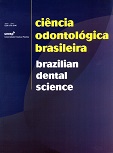Dimensional changes occurred in cast for complete dentures evaluated by tri-dimensional measurements
DOI:
https://doi.org/10.14295/bds.2007.v10i3.269Abstract
This study verified the dimensional changes occurred in stone casts by tri-dimensional design obtained from mathematical calculation. Dental stone casts were made in molds of addition silicone, alginate or impression compound relayed by alginate obtained from an aluminum pattern die. Screws were used to establish reference points of the distances, creating segments for area and volume calculation of the generated figures. Tri-dimensional measurement equipment fitted out with Renishaw PH9 measurement head and TP 200 searcher with 1mm diameter was used for this distance measurement. Computer Aided Design system was used to determine the X, Y, Z coordinates, which permitted to get the geometry dimensions. Results were submitted to statistical calculation and study of the differences (5%). Silicone impression produced casts with smaller dimensional changes and larger repetition capacity. The casts presented small variation of the variables values among the copies, when compared to alginate or impression compound relayed with alginate molds. Alginate produced casts with better copy fidelity, with absolute values of the variables close of the absolute values of the variables of the metallic die. Alginate presented good capacity to copy the metallic die among the impression materials, although in dimensional conditions no similarDownloads
Downloads
Published
How to Cite
Issue
Section
License
Brazilian Dental Science uses the Creative Commons (CC-BY 4.0) license, thus preserving the integrity of articles in an open access environment. The journal allows the author to retain publishing rights without restrictions.
=================




























